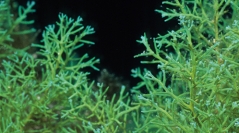

 Cryptogamie, Algologie
42 (6) - Pages 67-75
Cryptogamie, Algologie
42 (6) - Pages 67-75The shallow water canopy-forming alga Ericaria brachycarpa (J.Agardh) Molinari-Novoa & Guiry shows higher photosynthetic efficiency (α), maximum photosynthetic rates (Pmax), light at compensation (Ic) and dark respiration (Rd) in individuals collected at the lower depth limit of distribution of the species (20 m) than at shallower depths (2 and 10 m). Photosynthesis at saturation light levels (Psat) does not change in crossed transplants from 3 to 20 and from 20 to 3 m neither after 11 or 90 days. However, production at low light levels (Pb) increased in transplants from 3 to 20 m and decreased in transplants from 20 to 3 m after 90 days. Photosynthesis, both at high and low light levels increased from June to September. Seasonality explained most of the variance (70%) in the values of Psat, whilst transplantation explained 47% of the variance for Pb and Rd. Thus, E. brachycarpa is able to adapt its photosynthetic performances across its depth distribution limits and easily cope with sudden variations in the light environment associated or not with seasonality.
Photosynthesis, Ericaria brachycarpa, depth, adaptation, primary productivity